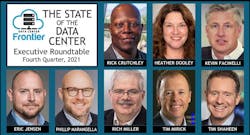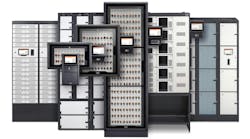Hyperscale Poised for More Growth in 2022, if Supply Chain Keeps Pace
The rapid growth of hyperscale computing is poised to continue in 2022, but the pace of that growth will depend upon how well the supply chain can keep pace, according to a panel of industry experts.
The future of the hyperscale market is just one of the topics we’ll examine this week in the Data Center Frontier Executive Roundtable, which features the insights of seven thought leaders on the state of the data center industry. Our Fourth Quarter 2021 roundtable will explore four topics: the outlook for hyperscale computing in 2022, trends in enterprise IT spending, the key themes in data center cooling, and the potential impact of “metaverse” technologies on the data center industry.
Here’s a look at our distinguished panel:
- Tim Shaheen, Executive Vice President of Strategy & Development for Aligned.
- Heather Dooley, Chairperson for the Infrastructure Masons IMWomen committee, and advisor at HDCManagement.
- Kevin Facinelli, Group President for Nortek Data Center Cooling, a segment of Nortek.
- Phillip Marangella, Chief Marketing Officer at EdgeConneX.
- Rick Crutchley, Vice President and General Manager of North America for Iron Mountain Data Centers.
- Eric Jensen, General Manager/Vice President of Data Aire.
- Tim Mirick, Senior Vice President Leasing & Marketing at Sabey Data Centers.
Each day this week I’ll moderate a Q&A with these executives on one of our key topics. We begin with our panel’s take on the trajectory of hyperscale computing.
Data Center Frontier: Several hyperscale operators have indicated they expect to boost capital investment in digital infrastructure in coming years. What’s the outlook for hyperscale computing in 2022, and what will this mean for data center developers and service providers?
TIM SHAHEEN, Aligned
Tim Shaheen, Aligned: Synergy Research Group recently reported that the number of hyperscale data centers globally has nearly doubled since 2016. The pipeline in North America shows no signs of slowing down and we are seeing quarter versus quarter growth from traditional and non traditional buyers primed to meet growing demand driven by tech, cloud, and content providers. This upturn in hyperscale activity will translate to an increase in hyperscale and cloud companies turning to providers for colocation and build to suit options as well as constructing their own facilities to support this level of scale.
Amongst others, there will be an increased focus from the providers’ on:
- securing land / having available capacity / patient, sophisticated capital to fund expansion at a rapid pace;
- mitigating supply shortages by having critical, long-lead finished goods in inventory;
- having a meaningful strategy to support scale and power allocation;
- addressing highly accelerated timelines and creative economic incentives;
- having a strategy to help these customers meet specific sustainability goals, with a heavy focus on energy efficiency and reducing water use; and
- retaining great teams to drive design and operational excellence amid an industry-wide labor shortage.
Additionally, providers will need to have the ability to be flexible, construct adaptive infrastructure and be able to problem-solve to meet requirements with speed and precision.
KEVIN FACINELLI, Nortek Data Center Cooling
Kevin Facinelli, Nortek: The hyperscale data center industry showed double digit increases in 2021. We expect similar growth in 2022, but now it depends on resolving current supply chain commodity and material bottlenecks that are facing all cooling equipment manufacturers. Hyperscale developers are also facing geographic location challenges. Developers are continually looking for locales with favorable climates where water and power resources are plentiful, especially for cooling the huge heat loads expected of tomorrow’s rack densities. Those three factors – climate, water and power – can significantly limit location choices.
Furthermore, governments increasingly want to regionalize data centers within their borders for data privacy and data transportation reasons. Those countries may have unfavorable climates, or power and water resources.
One solution that offsets all these challenges is the specification of cooling equipment that operates efficiently in almost any climate or resource-challenged geographic areas. Recent technological advancements in data center cooling now make it possible to achieve unprecedented levels of WUE 0.09 and pPUE of 1.06 (1.025 if fan coil wall energy is subtracted) depending on the local climate. Those statistics equate up to 90% and 50% less water and power usage respectively, versus traditional cooling methodologies. Consequently, this technology affords hyperscale data centers the flexibility and freedom to operate nearly any place on the globe.
TIM MIRICK, Sabey Data Centers
Tim Mirick, Sabey: Growth in the top markets has continued unabated, and I expect that won’t change in 2022. However, as hyperscale customers seek to lower latencies and push their services ever closer to populations, secondary markets should also see significant expansion.
Data center developers will naturally respond to this demand with investment in regionally strategic capacity while working to stay ahead of challenging supply chain delays. Delivering this capacity in flexible designs will be crucial to future-proofing customers’ ever-increasing densities. Further, the quest for net-zero carbon is only accelerating, and developers will continue to focus on greening their power options.
“As hyperscale customers push their services ever closer to populations, secondary markets should see significant expansion.”
Tim Mirick, Sabey Data Centers
RICK CRUTCHLEY of Iron Mountain.
Rick Crutchley, Iron Mountain: We had explosive demand in the fourth quarter of 2021. That will continue in 2022 due to massive online consumerism in the form of streaming, gaming, ecommerce and remote working.
The challenge for all service providers will be keeping up with that demand and delivering capacity when and where the end users need it. Data centers need to collaborate even more with their customers to meet demand.
We’ll see more investment based on continued demand that drives enhancement on platforms, apps and emerging technologies. Planning ahead with construction and location/site selection is key.
Competition is robust in the data center space, which is keeping pricing fairly level. We continue to face pandemic-related challenges, from rising construction costs to inflation and supply chain issues, which will impact construction cost per megawatt. While the pandemic continues to cause economic uncertainty, our end users seem positive and upbeat about the future. They seem more willing to invest in technology than they were at the beginning of the pandemic.
HEATHER DOOLEY, Infrastructure Masons and HDCManagement.
Heather Dooley, Infrastructure Masons: The industry continues to forecast robust growth both with new market development and increased capacity at current locations globally.
There is ever-increasing pressure to deliver capacity faster than in previous years, which can indicate more opportunity across the ecosystem to use developers and service providers in closer collaboration, as companies look to build partnerships to create new delivery models.
This demand will also continue to put pressure on supply chains and talent acquisition across the industry.
ERIC JENSEN, Data Aire
Eric Jensen, Data Aire: Demand for hyperscale deployments will continue to grow at the current pace or faster in the near term. However, 2022, is to some degree, in jeopardy. Money is as available as it’s ever been, yet there’s a distinct lack of resources — whether that’s the supply chain for both gear and ITE or labor.
This means projects that don’t get delivered as hoped and there is uncertainty of the capital investment that goes along with that.
PHILLIP MARANGELLA, EdgeConneX
Phillip Marangella: I think all providers across the digital infrastructure supply chain will be investing in build outs next year and for the coming years.
In particular, we are seeing surging demand in more distributed edge infrastructure at one end of the spectrum and hyperscale capacity expansion in more and more international markets.
NEXT: Our panel considers trends in enterprise IT spending for 2022
Keep pace with the fact-moving world of data centers and cloud computing by following us on Twitter and Facebook, connecting with DCF on LinkedIn, and signing up for our weekly newspaper using the form below:
About the Author




